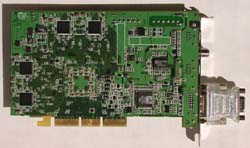ATI All-in-Wonder 9700 Pro Preview
by Matthew Witheiler on September 30, 2002 6:30 AM EST- Posted in
- GPUs
Making it Better: The All-in-Wonder 9700 Pro
The new All-in-Wonder 9700 Pro improves upon the already impressive All-in-Wonder 8500DV in a number of ways. The first way is by making use of a new VPU which provides unsurpassed gaming power.
As the name suggests, the All-in-Wonder 9700 Pro is based off of the Radeon 9700 (R300) graphics chip. Unlike some previous All-in-Wonder incarnations, the All-in-Wonder 9700 Pro comes clocked at the same speed as the flagship Radeon 9700 Pro. This leaves the All-in-Wonder 9700 Pro with the same impressive performance that the Radeon 9700 Pro demonstrates. Take a look at our rather lengthy Radeon 9700 Pro review to see just how fast the All-in-Wonder 9700 Pro will perform.
The use of the R300 core also gives the All-in-Wonder Radeon 9700 some distinct advantages when it comes to video processing and editing, but we will describe how in a bit.
The introduction of a new graphics core has historically been what pushes the All-in-Wonder series cards to a new product, so the addition of the R300 chip to the All-in-Wonder series came as no surprise to us. What did come as a pleasant surprise was the introduction of the long awaited Theater 200.

The Theater 200 serves as the successor to both the Rage Theater 1 chip and the Micronas stereo decoder that were present on all former All-in-Wonder incarnations. The Theater 200 chip is therefore a single chip analog video and stereo audio processor. On top of combining the two chips into one, the Theater 200 also makes improvements over the discrete parts.
On the video side the Theater 200 implements a new comb filter. A comb filter is the part of the video input system that separates a composite video signal's luminance information from its color information. A poor quality or non-optmized comb filter results in video artifacts after the separation takes place, since the luminance signal is not completely separated from the color signal. ATI has addressed this problem with their latest generation comb filter which was created in conjunction with ATI's set top box division. In theory the new comb filter should result in an improved composite video image
Also on the video side, the Theater 200 gets 12-bit analog to digital converters (ADCs). The 12-bit ADCs make for a better quality video signals than the previous 9-bit ADCs since they can better represent the analog signal digitally. ATI was quick to point out that all existing competing products use 9-bit or less ADCs.
ATI mentioned that on top of the performance benefits, the single chip solution was beneficial for the All-in-Wonder Radeon 9700 because it draws less power than two separate chips.
On the All-in-Wonder 9700 Pro ATI has gone back to using an analog TV tuner, unlike the digital one found on the Radeon 8500DV. The reason they cited for going with an analog tuner as opposed to a digital one was two fold. First off they did not see any benefit from using a digital tuner: as we described in our All-in-Wonder 8500DV article, the higher quality signal which theoretically comes from using a digital tuner is not noticeable on a television signal because of the poor quality of cable TV. We also found that the tuning was not a noticeable amount faster on the digital TV tuner even though in theory it should have been.
The second reason that ATI went back to using an analog TV tuner was because of the complexity and power associated with a digital tuner. Adding additional silicon on a card that already has many internal traces and consumes a good deal of power (more than any other consumer card out there) is not a simple task.
The card that ATI displayed for us featured BGA memory by Infineon and included the on-card power connector for external power. You may notice that the All-in-Wonder 9700 Pro does not have IEEE-1394 ports for digital video editing. These ports were left off due to power and space constraints but ATI is considering extending a special offer on their DV Wonder IEEE-1394 card to those who buy an All-in-Wonder 9700 Pro.
The breakout box remains the same as the one on the All-in-Wonder 8500 series cards.












0 Comments
View All Comments